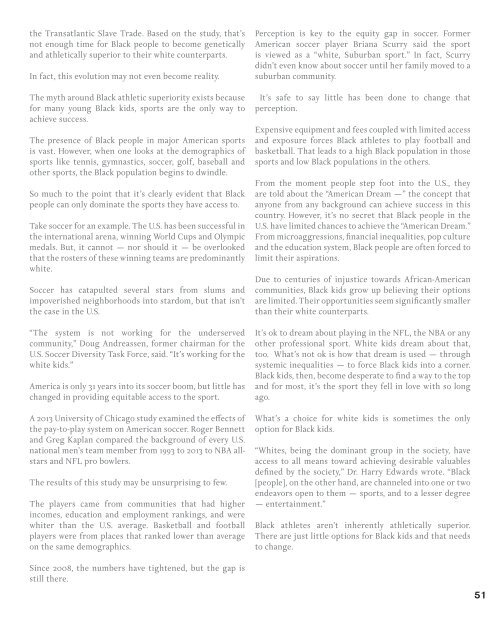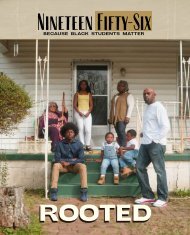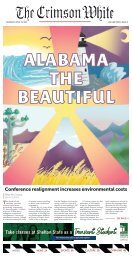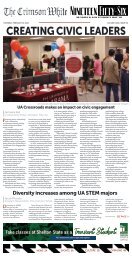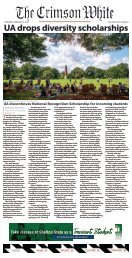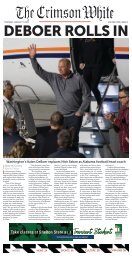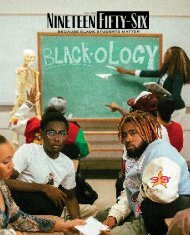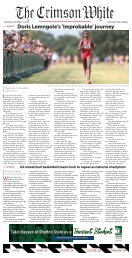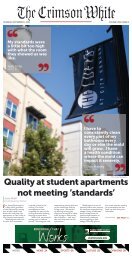Nineteen Fifty-Six Vol. 2 No. 5
This is the 2022 print edition of Nineteen Fifty-Six magazine. The theme "Movin' On Up" is inspired by the Black Panther Party.
This is the 2022 print edition of Nineteen Fifty-Six magazine. The theme "Movin' On Up" is inspired by the Black Panther Party.
Create successful ePaper yourself
Turn your PDF publications into a flip-book with our unique Google optimized e-Paper software.
the Transatlantic Slave Trade. Based on the study, that’s<br />
not enough time for Black people to become genetically<br />
and athletically superior to their white counterparts.<br />
In fact, this evolution may not even become reality.<br />
The myth around Black athletic superiority exists because<br />
for many young Black kids, sports are the only way to<br />
achieve success.<br />
The presence of Black people in major American sports<br />
is vast. However, when one looks at the demographics of<br />
sports like tennis, gymnastics, soccer, golf, baseball and<br />
other sports, the Black population begins to dwindle.<br />
So much to the point that it’s clearly evident that Black<br />
people can only dominate the sports they have access to.<br />
Take soccer for an example. The U.S. has been successful in<br />
the international arena, winning World Cups and Olympic<br />
medals. But, it cannot — nor should it — be overlooked<br />
that the rosters of these winning teams are predominantly<br />
white.<br />
Soccer has catapulted several stars from slums and<br />
impoverished neighborhoods into stardom, but that isn’t<br />
the case in the U.S.<br />
“The system is not working for the underserved<br />
community,” Doug Andreassen, former chairman for the<br />
U.S. Soccer Diversity Task Force, said. “It’s working for the<br />
white kids.”<br />
America is only 31 years into its soccer boom, but little has<br />
changed in providing equitable access to the sport.<br />
A 2013 University of Chicago study examined the effects of<br />
the pay-to-play system on American soccer. Roger Bennett<br />
and Greg Kaplan compared the background of every U.S.<br />
national men’s team member from 1993 to 2013 to NBA allstars<br />
and NFL pro bowlers.<br />
The results of this study may be unsurprising to few.<br />
The players came from communities that had higher<br />
incomes, education and employment rankings, and were<br />
whiter than the U.S. average. Basketball and football<br />
players were from places that ranked lower than average<br />
on the same demographics.<br />
Perception is key to the equity gap in soccer. Former<br />
American soccer player Briana Scurry said the sport<br />
is viewed as a “white, Suburban sport.” In fact, Scurry<br />
didn’t even know about soccer until her family moved to a<br />
suburban community.<br />
It’s safe to say little has been done to change that<br />
perception.<br />
Expensive equipment and fees coupled with limited access<br />
and exposure forces Black athletes to play football and<br />
basketball. That leads to a high Black population in those<br />
sports and low Black populations in the others.<br />
From the moment people step foot into the U.S., they<br />
are told about the “American Dream —” the concept that<br />
anyone from any background can achieve success in this<br />
country. However, it’s no secret that Black people in the<br />
U.S. have limited chances to achieve the “American Dream.”<br />
From microaggressions, financial inequalities, pop culture<br />
and the education system, Black people are often forced to<br />
limit their aspirations.<br />
Due to centuries of injustice towards African-American<br />
communities, Black kids grow up believing their options<br />
are limited. Their opportunities seem significantly smaller<br />
than their white counterparts.<br />
It’s ok to dream about playing in the NFL, the NBA or any<br />
other professional sport. White kids dream about that,<br />
too. What’s not ok is how that dream is used — through<br />
systemic inequalities — to force Black kids into a corner.<br />
Black kids, then, become desperate to find a way to the top<br />
and for most, it’s the sport they fell in love with so long<br />
ago.<br />
What’s a choice for white kids is sometimes the only<br />
option for Black kids.<br />
“Whites, being the dominant group in the society, have<br />
access to all means toward achieving desirable valuables<br />
defined by the society,” Dr. Harry Edwards wrote. “Black<br />
[people], on the other hand, are channeled into one or two<br />
endeavors open to them — sports, and to a lesser degree<br />
— entertainment.”<br />
Black athletes aren’t inherently athletically superior.<br />
There are just little options for Black kids and that needs<br />
to change.<br />
Since 2008, the numbers have tightened, but the gap is<br />
still there.<br />
51


